Repair of coils of electromagnetic relays and starters
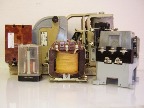 During work windings of various electrical devices are damaged: breaks in wires, the appearance of winding circuits, carbonization of the insulation are observed.
During work windings of various electrical devices are damaged: breaks in wires, the appearance of winding circuits, carbonization of the insulation are observed.
Tearing of a thin (0.07 — 0.1 mm) winding wire, most often occurring at the place where the wires are soldered, can occur due to inaccurate removal of the wire enamel with a knife, scissors or other sharp objects (wire cutting) , the use of various ointments for soldering the wire, compounds that subsequently corrode the copper wire (wire corrosion), etc.
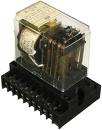 Turn defects in the windings arise from the destruction of the enamel coating, which occurs as a result of a factory defect in the wire or when the temperature of the coil exceeds the permissible value (for example, if the coil is incorrectly calculated or if it is turned on incorrectly at an increased voltage).
Turn defects in the windings arise from the destruction of the enamel coating, which occurs as a result of a factory defect in the wire or when the temperature of the coil exceeds the permissible value (for example, if the coil is incorrectly calculated or if it is turned on incorrectly at an increased voltage).
Defects in rotation that occurred during operation often lead to the destruction of not only the entire coil, but also to the destruction of the frame.
Various mechanical damage to the insulation when assembling and disassembling magnetic circuits can also damage the coil.
If the coil is damaged (open circuit, short circuit, etc.), it is removed from the magnetic circuit and repaired.
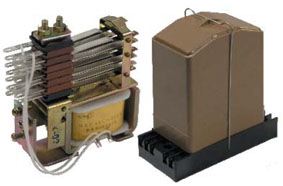
Electromagnetic relay MKU-48
Before cutting or unwinding a coil with a wire break, it is necessary to carefully check, remove the outer insulation and make sure that the break did not occur at the outer terminal. Otherwise, the integrity of the coil can be easily restored by soldering the broken end of the wire to the terminal and insulating the soldering point.
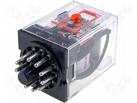 If the break occurs somewhere inside the coil, the coil is unwound until the break is found, then the integrity of the remaining unwound coil is checked, and if the rest is not damaged, soldering is performed, it is insulated, and the wound part of the turns is wound with a new wire of the same diameter.
If the break occurs somewhere inside the coil, the coil is unwound until the break is found, then the integrity of the remaining unwound coil is checked, and if the rest is not damaged, soldering is performed, it is insulated, and the wound part of the turns is wound with a new wire of the same diameter.
When a break is detected near the start of the winding, the winding is rewound to eliminate unnecessary soldering, which reduces the reliability of the winding.
If only the coil is damaged, the coil is removed from the magnetic circuit so that the frame is not damaged, then, if the label of the coil is preserved or the number of turns and the diameter of the wire are known, the entire coil can be cut off (if it is impregnated with varnish or compound) or unrolled.
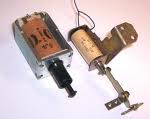 Coils impregnated with varnish or compound with a wire diameter of more than 0.3 mm cannot be removed from the pressed frame without damaging it. Such a coil is completely replaced with a new one.
Coils impregnated with varnish or compound with a wire diameter of more than 0.3 mm cannot be removed from the pressed frame without damaging it. Such a coil is completely replaced with a new one.
The assembly frame, if made without «shoulders», can be easily disassembled without removing the damaged coil. The loose parts of the carcass can be reassembled and the carcass is ready to be rolled again.
The damaged reel, the label of which is not preserved and the data of which is unknown, is well fixed on the spindle of the winding machine and is unwound by hand. The counter installed on the machine will show the number of turns, and the diameter of the wire is measured with a micrometer.
If the frame is damaged, it is redone. The coil terminals, if possible, remain the same.
In order to remove the damaged coils, in most cases it is necessary to disassemble the magnetic cores. For direct current relays, solid magnetic circuits are used, made of strip or round material — structural steel, iron, round silicon steel. For relays operating on alternating current, laminated magnetic circuits are used, which are rivets of steel of various brands.
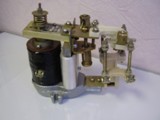 The magnetic circuit consists of a core on which a coil is mounted, a movable armature and a yoke.
The magnetic circuit consists of a core on which a coil is mounted, a movable armature and a yoke.
Fastening the coils of the magnetic circuit is done in different ways. The simplest is to mount it with a pole in DC systems (for example, electromagnetic relays of the RP-23 type).
V intermediate relays of type RP-250 (code relays), the windings are attached to the core either by means of a shaped plate that holds the armature on the yoke of the magnetic circuit, or by means of special copper and insulating washers mounted on the core.
In an MKU type relay, the coil mounted on the core is fixed with a special plate, which for the AC system is made of copper and is a short circuit.
In alternating current systems with laminated cores, the windings can be secured either by means of a short-circuit-relay type MKU, RP-25. PR-321, RP-341, RP-210, etc., and using metal plates, rivets with a core and bent after mounting the coil (some types magnetic starters).
There are magnetic circuits, in the core of which the coil is held by a solid nozzle or wedge plates of laminated plastic, and in some cases of phosphor bronze.
Regardless of the fastening of the coils, when replacing them with new ones, it is necessary to disassemble the relay or other apparatus to one degree or another. Only those elements that prevent the removal of the coil are subject to disassembly.
After installing a new coil on the core, fixing it and assembling the magnetic circuit, the relay is adjusted mechanically.
